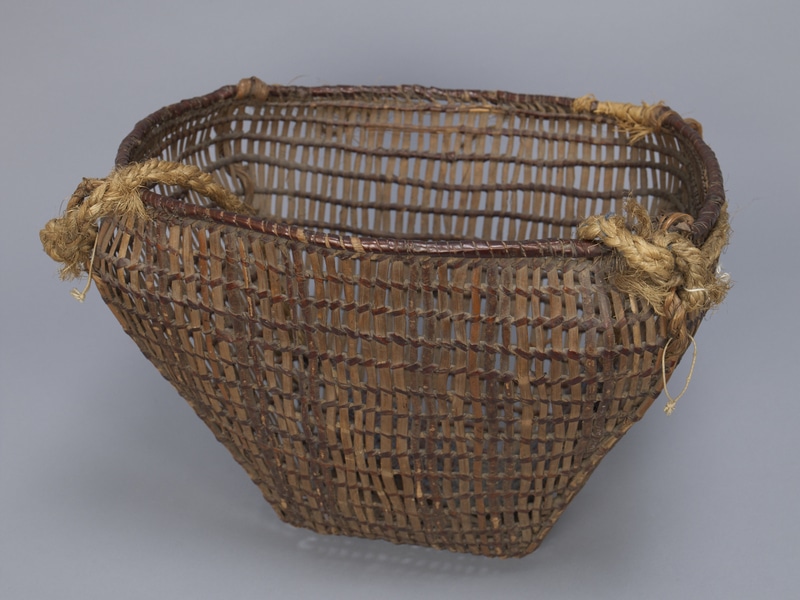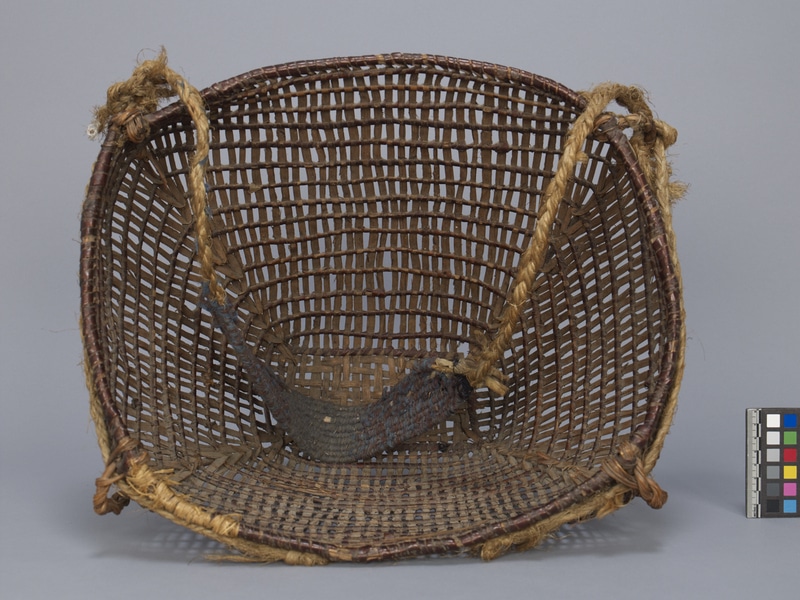Basket Item Number: 3131/7 from the MOA: University of British Columbia



Description
Large burden basket with strap. Basket is constructed in a sturdy, open weave, wide at the mouth, narrowing sharply to a small rectangular base. Base is woven in a herringbone pattern. The lip is wrapped with cherry bark, which is also used as a decorative element in the body of the basket as strands of the warp. A rope of coarse plant fibre is attached around the lip by twists of cedar root, with a carrying strap of woven wool in dark brown and blue attached on one side.
History Of Use
Used daily to harvest shellfish and carry fish, this burden basket is an example of Indigenous women’s basketry proficiency from the late 19th century. The inside of this basket is still coated with silty clay from the clams draining as they were piled inside. Given their heavy use, functional baskets like this have rarely been preserved, especially in such good condition -- in contrast to the more commonly collected, coiled and decorated cedar-root basketry of the same period. It is also one of few examples of this type complete with tumpline in Canadian museums.
Narrative
Cultural origin is uncertain. Construction techniques are similar to Makah or Nuu-chah-nulth baskets, whereas the tumpline-used on the wearer’s forehead or across the shoulders to carry the load, is similar to Fraser Valley Coast Salish tumplines. Diane Anderson bought it at the Chippewa Trading Post in Ontario, in 1989. It was tagged as a "19th C Salish burden basket".
Specific Techniques
Cherry bark used as a structural element to twine the cedar root and wrap the rim. Other materials are cedar withe. The tumpline is made of hemp and wool, with cotton inside. The basket’s base is created using a two-over, two-under twill, while the sides are wrapped-twined, using cherry bark strips in such a way that they form a herringbone design.
Item History
- Made in Vancouver Island, British Columbia, Canada between 1890 and 1900
- Owned by Diane J. Anderson
- Owned by Craig Anderson, Reid Anderson and Dana Anderson-Breau before October 2, 2015
- Received from Craig Anderson (Donor), Reid Anderson (Donor) and Dana Anderson-Breau (Donor) on October 2, 2015
What
- Name
- Basket
- Identification Number
- 3131/7
- Type of Item
- basket
- Material
- cedar root, cherry bark, hemp stem, wool fibre, cotton fibre and cedar withe
- Overall
- height 33.5 cm, width 41.0 cm, depth 36.0 cm
Who
- Culture
- Nuu-chah-nulth ? or Coast Salish ?
- Previous Owner
- Diane J. Anderson, Craig Anderson, Reid Anderson and Dana Anderson-Breau
- Received from
- Craig Anderson (Donor), Reid Anderson (Donor) and Dana Anderson-Breau (Donor)
Where
- Holding Institution
- MOA: University of British Columbia
- Made in
- Vancouver Island, British Columbia, Canada
When
- Creation Date
- between 1890 and 1900
- Ownership Date
- before October 2, 2015
- Acquisition Date
- on October 2, 2015
Other
- Item Classes
- basketry
- Condition
- fair
- Accession Number
- 3131/0007